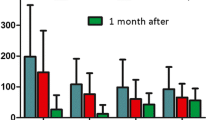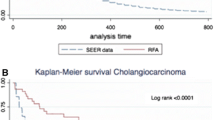Abstract
Background
Pancreatic carcinoma is often inoperable, carries a poor prognosis, and is commonly complicated by malignant biliary obstruction. Phase I/II studies have demonstrated good safety and early stent patency using endoscopic biliary radiofrequency ablation (RFA) as an adjunct to self-expanding metal stent (SEMS) insertion for biliary decompression.
Aim
To analyze the clinical efficacy of endobiliary RFA.
Methods
Retrospective case–control analysis was carried out for 23 patients with surgically unresectable pancreatic carcinoma and malignant biliary obstruction undergoing endoscopic RFA and SEMS insertion and 46 controls (SEMS insertion alone) in a single tertiary care center. Controls were stringently matched for age, sex, metastases, ASA/comorbidities. Survival, morbidity, and stent patency rates were assessed.
Results
RFA and control groups were closely matched—ASA 2.35 ± 0.65 versus 2.54 ± 0.50, p = 0.086; metastases 9/23 (39.1 %) versus 18/46 (39.1 %), p = 0.800; chemotherapy 16/23 (69.6 %) versus 24/46 (52.2 %), p = 0.203. Median survival in RFA group was 226 days (IQR 140–526 days) versus 123.5 days (IQR 44–328 days) in controls (p = 0.010). RFA was independently predictive of survival at 90 days (OR 21.07, 95 % CI 1.45–306.64, p = 0.026) and 180 days (OR 4.48, 95 % CI 1.04–19.30, p = 0.044) in multivariate analysis. SEMS patency rates were equivalent in both groups. RFA was well tolerated with minimal side effects.
Conclusions
Endoscopic RFA is a safe and efficacious adjunctive treatment in patients with advanced pancreatic malignancy and biliary obstruction and may confer early survival benefit. Randomized prospective clinical trials of this new modality are mandated.



Similar content being viewed by others
References
Ghaneh P, Costello E, Neoptolemos JP. Biology and management of pancreatic cancer. Gut. 2007;56:1134–1152.
Herrmann R, Bodoky G, Ruhstaller T, et al. Gemcitabine plus capecitabine compared with gemcitabine alone in advanced pancreatic cancer: a randomized, multicenter, phase III trial of the Swiss Group for Clinical Cancer Research and the Central European Cooperative Oncology Group. J Clin Oncol. 2007;25:2212–2217.
Verslype C, Prenen H, Van Cutsem E. The role of chemotherapy in biliary tract carcinoma. HPB (Oxford). 2008;10:164–167.
Davids PH, Groen AK, Rauws EA, Tytgat GN, Huibregtse K. Randomised trial of self-expanding metal stents versus polyethylene stents for distal malignant biliary obstruction. Lancet. 1992;340:1488–1492.
O’Brien S, Hatfield AR, Craig PI, Williams SP. A three year follow up of self expanding metal stents in the endoscopic palliation of longterm survivors with malignant biliary obstruction. Gut. 1995;36:618–621.
Sutherland LM, Williams JA, Padbury RT, Gotley DC, Stokes B, Maddern GJ. Radiofrequency ablation of liver tumors: a systematic review. Arch Surg. 2006;141:181–190.
Itoi T, Isayama H, Sofuni A, et al. Evaluation of effects of a novel endoscopically applied radiofrequency ablation biliary catheter using an ex vivo pig liver. J Hepatobiliary Pancreat Sci. 2012;19:543–547.
Steel AW, Postgate AJ, Khorsandi S, et al. Endoscopically applied radiofrequency ablation appears to be safe in the treatment of malignant biliary obstruction. Gastrointest Endosc. 2011;73:149–153.
Wadsworth CA, Westaby D, Khan SA. Endoscopic radiofrequency ablation for cholangiocarcinoma. Curr Opin Gastroenterol. 2013;29:305–311.
Tal AO, Vermehren J, Friedrich-Rust M, et al. Intraductal endoscopic radiofrequency ablation for the treatment of hilar non-resectable malignant bile duct obstruction. World J Gastrointest Endosc. 2014;6:13–19.
Figueroa-Barojas P, Bakhru MR, Habib NA, et al. Safety and efficacy of radiofrequency ablation in the management of unresectable bile duct and pancreatic cancer: a novel palliation technique. J Oncol. 2013;2013:910897.
Mizandari M, Pai M, Xi F, et al. Percutaneous intraductal radiofrequency ablation is a safe treatment for malignant biliary obstruction: feasibility and early results. Cardiovasc Intervent Radiol. 2013;36:814–819.
Sharaiha RZ, Natov N, Glockenberg KS, Widmer J, Gaidhane M, Kahaleh M. Comparison of metal stenting with radiofrequency ablation versus stenting alone for treating malignant biliary strictures: is there an added benefit? Dig Dis Sci. 2014;59:3099–3102.
Dolak W, Schreiber F, Schwaighofer H, et al. Endoscopic radiofrequency ablation for malignant biliary obstruction: a nationwide retrospective study of 84 consecutive applications. Surg Endosc. 2014;28:854–860.
Cote GA, Kumar N, Ansstas M, et al. Risk of post-ERCP pancreatitis with placement of self-expandable metallic stents. Gastrointest Endosc. 2010;72:748–754.
Alis H, Sengoz C, Gonenc M, Kalayci MU, Kocatas A. Endobiliary radiofrequency ablation for malignant biliary obstruction. Hepatobiliary Pancreat Dis Int (HBPD Int). 2013;12:423–427.
Hu B, Gao DJ, Wu J, Wang TT, Yang XM, Ye X. Intraductal radiofrequency ablation for refractory benign biliary stricture: pilot feasibility study. Dig Endosc. 2014;26:581–585.
Cunningham D, Chau I, Stocken DD, et al. Phase III randomized comparison of gemcitabine versus gemcitabine plus capecitabine in patients with advanced pancreatic cancer. J Clin Oncol. 2009;27:5513–5518.
Conroy T, Desseigne F, Ychou M, et al. FOLFIRINOX versus gemcitabine for metastatic pancreatic cancer. N Engl J Med. 2011;364:1817–1825.
Hansler J, Wissniowski TT, Schuppan D, et al. Activation and dramatically increased cytolytic activity of tumor specific T lymphocytes after radio-frequency ablation in patients with hepatocellular carcinoma and colorectal liver metastases. World J Gastroenterol. 2006;12:3716–3721.
den Brok MH, Sutmuller RP, van der Voort R, et al. In situ tumor ablation creates an antigen source for the generation of antitumor immunity. Cancer Res. 2004;64:4024–4029.
Ortner ME, Caca K, Berr F, et al. Successful photodynamic therapy for nonresectable cholangiocarcinoma: a randomized prospective study. Gastroenterology. 2003;125:1355–1363.
Bown SG, Rogowska AZ, Whitelaw DE, et al. Photodynamic therapy for cancer of the pancreas. Gut. 2002;50:549–557.
Conflict of interest
Nagy Habib, stockholder and director of EMcision Ltd, UK. Yiannis Kallis, Natalie Phillips, Alan Steel, Harry Kaltsidis, Panagiotis Vlavianos and David Westaby have no potential conflicts to disclose.
Author information
Authors and Affiliations
Corresponding author
Rights and permissions
About this article
Cite this article
Kallis, Y., Phillips, N., Steel, A. et al. Analysis of Endoscopic Radiofrequency Ablation of Biliary Malignant Strictures in Pancreatic Cancer Suggests Potential Survival Benefit. Dig Dis Sci 60, 3449–3455 (2015). https://doi.org/10.1007/s10620-015-3731-8
Received:
Accepted:
Published:
Issue Date:
DOI: https://doi.org/10.1007/s10620-015-3731-8




